- Connect the red jump lead to the positive terminal of the dead battery (or the jump-start terminal on a car with a battery located elsewhere).
- Connect the other end of the red lead to the positive terminal of the booster battery or jump start terminal.
- Connect the black jump lead to the negative terminal of the booster battery or jump start terminal.
- Connect the other end of the black cable to a well-grounded bolt or bracket on the engine block of the vehicle being jumped, not the battery itself. This prevents sparks near the battery which may cause an explosion.
- Start the engine of the vehicle with the good battery and let it run at idle to charge both batteries for a few minutes.
- Start the engine of the vehicle with the discharged battery.
- Reduce the engine speed to idle on both vehicles.
- Remove the jump leads in the reverse order they were attached, making sure to never touch the red and black terminals to each other. If the charging system and the battery of the car which had to be jumped are in good condition, 20-30 minutes of driving should bring it back up to a full charge.
This is the quick guide to jump-starting a car – for the full details, tap here.
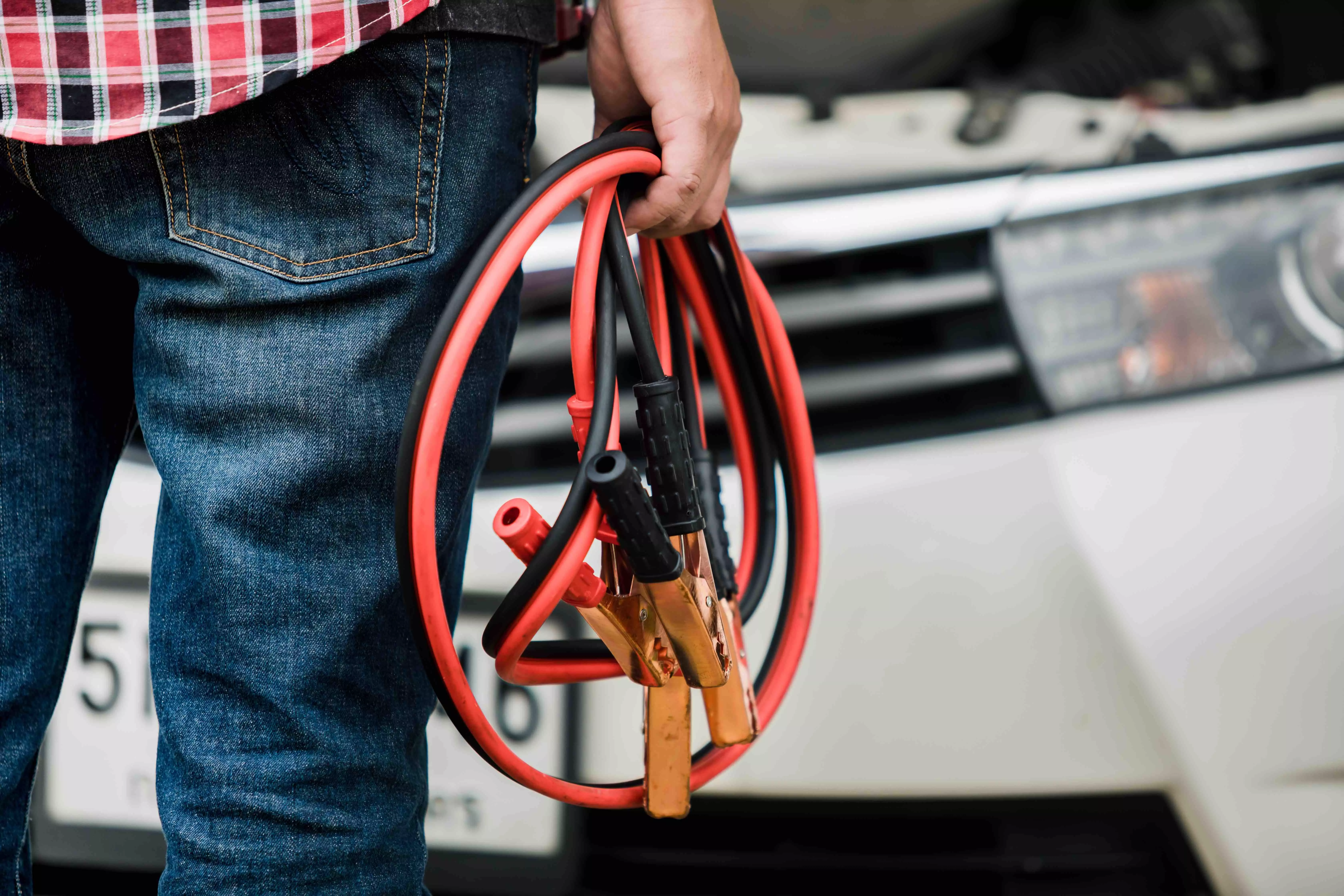
How much could I save by DIY jump-starting?
Many of us pay for a breakdown service that will come to your rescue when you're stranded at home, as well as when you're away from it. Unless you repeatedly call them out to fix the same issue, you're unlikely to be charged for the mechanic's time. However, come renewal time, you won't benefit from any 'no claims' discount that is sometimes applied to customers who haven't had to call upon the breakdown company's services in the previous year.
That discount could amount to £50 or more, depending on how generous the company is feeling/how savvy you are when you call them to discuss your renewal quote.
Jump-start car in 8 easy-to-follow steps
Never jump-started a car with leads before? You've either been lucky or you've had someone else to do it for you. Jump starting is something that almost all of us will have to do one day, and there are several important rules to follow when using jump leads.
In this walkthrough, we focus on how to jump-start a car with leads connected to another car's battery rather than with a portable battery jump start pack.
Let's start with the key things to know about this method of getting some charge back into your car's battery, which will enable you to start or continue your journey.
What to do before you use leads to jump-start a car
- First, read your car's manual to see if there are specific jump-starting instructions for your model. For example, some cars have two batteries – one that is used for starting and another to maintain the car's electronics. So you'll need to know which is which.
- Careless jump starting, particularly if the leads are allowed to spark, can cause damage to the car’s electronic components. Some cars, such as certain BMWs, are fitted with special connectors to allow jump-starting, and on these models the jump leads should only be connected to the special terminals provided. Again, you'll find details in your manual.
- Jump leads often allow only limited current flow, and some are designed to be used with engines of a particular capacity. Depending on how much the battery is discharged, jump leads may or may not start a vehicle with a weak battery.
- A 1.0-litre city car isn’t going to jump-start a Range Rover. You need cars of comparable size.
- Locate the flat battery and the donor vehicle's battery. Move the latter vehicle as close as you can to the flat battery so that the jumper cables will reach easily, but make sure the vehicles aren't touching (this is very important).
- Make sure the cables are not in the way of the fan, drive belts or any other moving parts for when the vehicles are started.
- Make sure the booster battery is the same voltage as the flat one – all modern car batteries are 12 volts.
- Make sure the ignition switch is in the 'off' position and the transmission is in Neutral (manual) with the parking brake set, or Park (Automatic).
- Turn off the lights and other electrical loads on the car with the dead battery but turn on the heater blower motor, which will minimise the damage an excessive electrical surge can cause.
- Wear safety goggles. There's always a small chance of an explosion – batteries are full of acid.
- A jump pack may be more useful for future 'events'. These pocket-sized lithium-ion battery packs cost from around 50 quid and are an absolute godsend when you can't find your jump leads or another vehicle.

Which jump leads do I need for my car?
Not all leads are created equal for the purpose of jump-starting a car. Decent jump leads should have both length and girth. A thicker cable can transfer more electrical current, giving your dead battery a better boost. This is especially important if your car has a large engine or is equipped with engine start-stop technology because both require a heavy-duty battery. The packaging will say what size engine the leads are suitable for.
It's better to buy thicker leads, even if you have a car with a small engine, because you may change it for a larger car at some point or you may want to loan your leads to a stranded neighbour or stranger who needs to jump-start their own vehicles.
As for length, 3 metres/10 feet is fine if both cars are parked close to each other, but 5-metre cables or longer could be useful if you’re stranded in a tight spot. However, the longer the cable, the thicker it’ll need to be in order to transfer the same current.
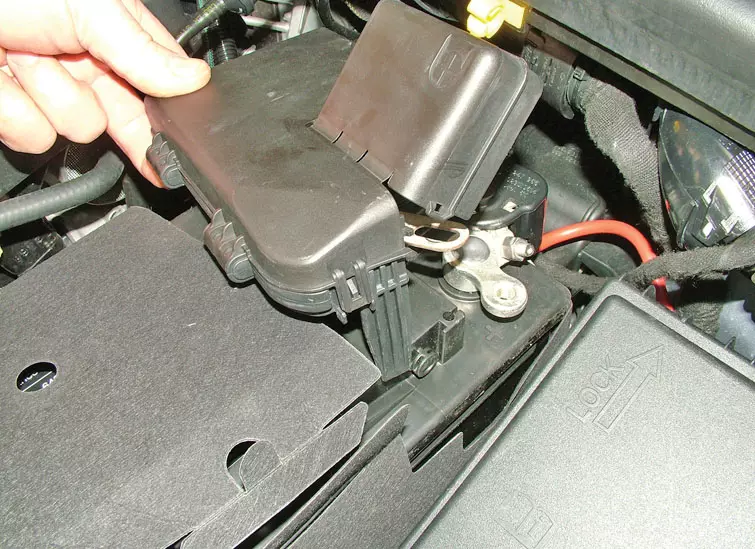
How to jump-start a car in 8 steps:
1. Which one is the positive terminal?
With the cars parked next to each other and the engines turned off (see above), connect one end of the red jump lead to the flat battery, which will usually be in the engine bay, but it may be in the boot.
There are two terminals (short stubs) on the top of the battery. The positive terminal is the one we want first and it'll likely be marked by a '+' (plus) symbol, it may have a red cable attached to it, or it could be covered by a protective flap, as shown above.
It is imperative to know which terminal is which, because connecting jumper cables incorrectly will result in damage to your car's electrical systems.
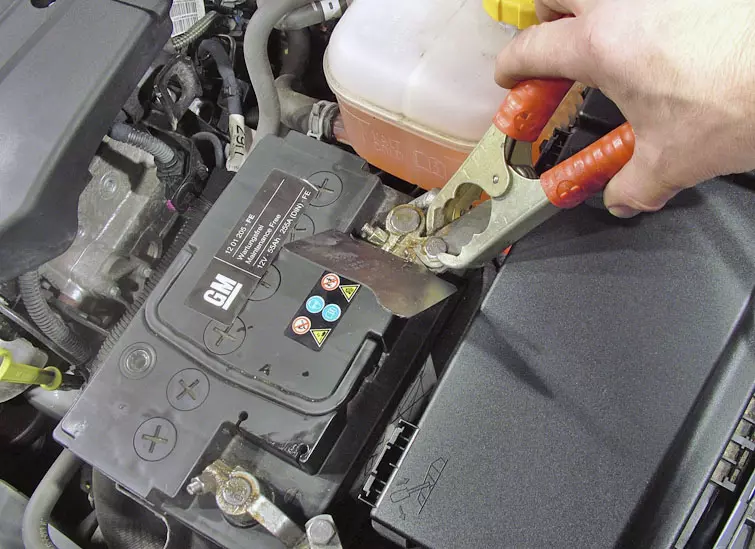
2. How do I attach the red lead?
All jump lead 'jaws' are spring-loaded. You squeeze the handles to open the jaws. Releasing the handles clamps the jaws tightly around whatever they're in contact with – in this case the positive terminal. Never be tempted to try them on a finger – they're very strong and will cut you!
Make sure the jaws have a secure metal-to-metal connection, and check that the other end of the cable isn't about to contact another metal object, such as the car body.
The second (black) jump lead should also be well out of the way at this point to avoid possible short circuits. We'll get onto that lead shortly.
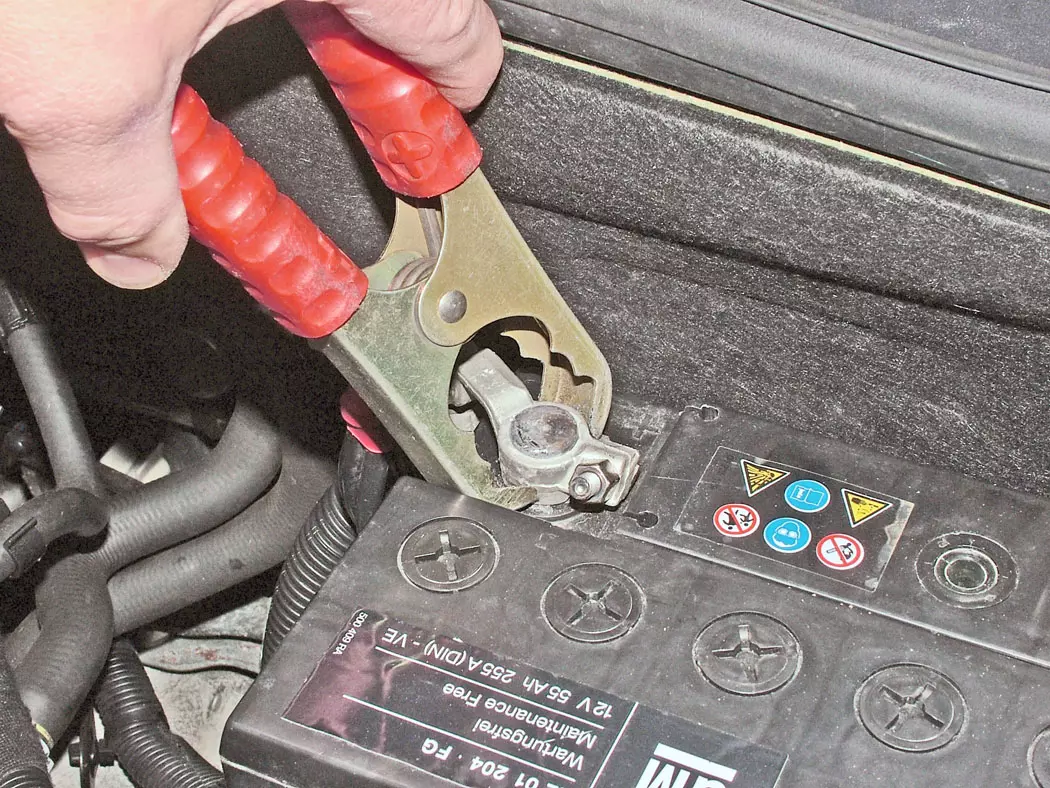
3. Where do I put the other end of the red jump lead?
Once you've worked out where the battery is in the donor vehicle and have parked the vehicle as close to the dead car as possible, without them touching, turn the engine off.
Connect the other end of the red positive lead to the donor car's battery, having removed any cover or flaps from the positive terminal first. You've probably just discovered why it helps to buy jump leads that are as long as possible – longer jump leads come in very handy when you're unable to park as close to the dead car as you like.
The black lead still isn't needed yet, so make sure it's not involved at this stage.

4. Where does the black jump lead need to go to first?
The first black lead connection should be made to the negative terminal on the donor car’s battery, not the flat battery. You should have already checked which terminal was which on the donor vehicle before you connected the red lead, but the negative terminal is marked with a '-' (minus) symbol – the symbol is often very small so use your smartphone's flash to shed some light on it.
Again, ensure the other end of the cable isn't contacting anything metal. It can trail on the ground, as long as it's kept away from metal objects such as railings or a fence that might be lining your drive.
Don't forget that the donor vehicle's engine should still be switched off at this stage. We'll get to that bit in a minute, once all of the jump leads' jaws are in contact with metal.
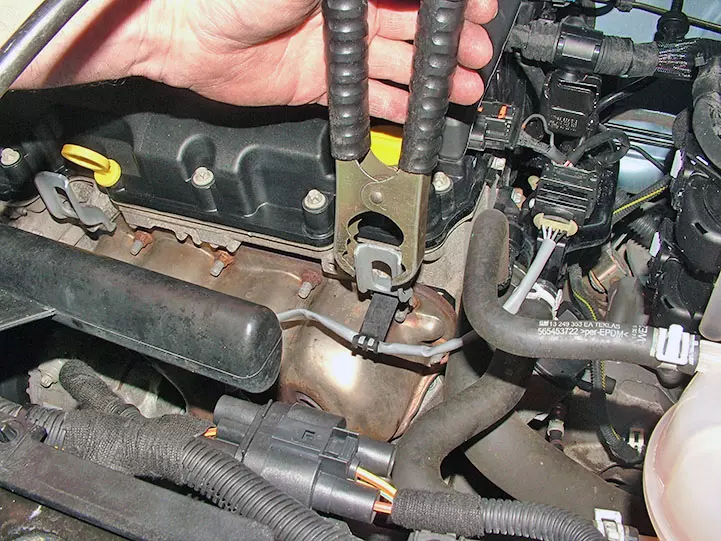
5. Where do you ground when jumping a car?
The other end of the black jump lead should not be connected to the dead car's battery. That would create sparks, and since a dead battery can leak flammable hydrogen gas, that's not advisable.
Instead, the fourth and final connection is made to a metal grounding point. Look for some solid, unpainted and un-chromed metal in the engine bay, away from any moving parts such as fans or belts. A spot on your car's engine block is an ideal place to clamp on to.
6. Which car do you start first when jumping a dead battery?
With all of the leads connected, wait a few minutes before starting the donor car's engine. Allow it to run at idle for five minutes. This gives it time to supply some charge to the dead car's battery.
7. Now can I jump-start my car?
Yes. If it fires up, leave the engine running and unclamp the jump leads in the reverse order to how they were attached, being careful to avoid them touching each other as you unclamp them.
8. Can I switch off now?
No! It takes time for your car's flat battery to be fully recharged by your engine's alternator, and the quickest way to generate juice is to go for a drive of at least 20 minutes. Just make sure you don't stall your car because you may not be able to restart it.
Unless there's an obvious explanation for this battery blip – such as leaving your headlights on with the engine off – your battery could just be ripe for replacement.
Car batteries have a lifespan of around five years, with extreme winters and sweltering summers accelerating their deterioration. If you've got a multimeter handy, check how much voltage the battery is outputting (12.6 volts or higher is optimal, anything less than 12V is bad news).
Battery can’t be jump started? Watch this video to see how to change your battery
Battery renewal is a straightforward job that any amateur mechanic can do. This Haynes video shows how it is done on a Ford S-Max/Galaxy.
Your vehicle's battery may be located in a different part of the engine bay (or even in the boot), but the method is the same for all makes and models.
